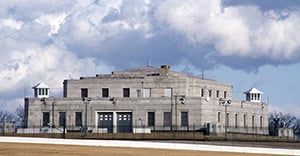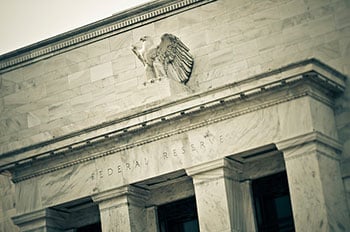Auditing America's Gold Reserves
The Sound Money Defense League is rallying Americans to demand a full and complete audit of America's gold reserves. Accordingly, we support the Gold Reserves Transparency Act which Rep. Alex Mooney (R-WV) introduced in the U.S. House of Representatives in 2019.
The federal authorities who control our nation's once-vast gold reserves at Ft. Knox and elsewhere have refused to allow a comprehensive audit to be conducted since the Eisenhower Administration!
Has the U.S. gold reserve been whittled away to finance wild federal spending? Has America's gold been shipped to New York to dump on the market? Or has any been sent to China to cover our debts?
With financial turmoil rising globally and with growing concerns that a portion of America's gold reserves may have been sold, leased, pledged, or otherwise encumbered, it's vital a full and complete audit be conducted in order to restore the confidence of the American people that our nation's most important monetary assets are safe.
The U.S. Bullion Depository at Fort Knox Has a Curious History of Secrecy
When President Franklin Roosevelt ordered Americans in 1933 to surrender their gold to the government, he suddenly found he needed a place to put all those millions of gold coins.
Roosevelt's infamous Executive Order 6102 gave Americans one month to give up their gold pocket change and gave FDR the ability to print and spend all the money he liked. It was viewed suspiciously and was widely unpopular, but it was largely obeyed. Millions of gold coins were dutifully taken to banks by bewildered but patriotic Americans to trade for paper dollars.

Fort Knox, Kentucky
Roosevelt was faced with assuring the nation that confiscated gold still belonged to all of America, and was properly safeguarded. And so the plans for The United States Bullion Depository were born. An army base near Louisville, Kentucky was chosen for its geographical location, secure in almost the very center of the nation, hundreds of miles from America's coastlines, where any future invading enemies would first put their boots on America's ground.
Construction for the massive fortress that would become so much a part of American legend and lore
began in 1936 and took a year. Beginning in January 1937, trainloads of American gold under the guard of armed soldiers arrived at Kentucky's Fort Knox, to store away what was still reverently called the “nation's gold.”
As the boxcars' gold was unloaded into vaults behind 20,200 cubic feet of granite and concrete and a 22 ton door, it would be, with few exceptions, the last time Americans had any glimpse of the same gold they carried in their pants pockets a few years earlier
Today, Fort Knox is paradoxically a symbol of American strength, power, and prestige, while at the same time, the center of controversy, suspicion, and political intrigue. The question on the minds of American taxpayers and a high number of Congressmen is whether or not Fort Knox still has the gold stored for safeguarding eighty years ago. Those questions abound for one particular reason: The U.S. government refuses to talk about gold.
We know that the last somewhat credible examination of Fort Knox's gold was in 1953. Rumors and reports that gold was being bled from Fort Knox to help pay the bills of WWII and the Korean War caused Dwight Eisenhower to reassure America its gold in Fort Knox was still safe. There is no evidence that inspection was a thorough audit (reports said it was a spot check of only about 6% of the gold), but final reports decided all was in order.
American voters and Congress, satisfied that America's gold was accounted for, let the matter lay for the next twenty years,. But national debt piling up from the Vietnam War and the massive welfare programs of Lyndon Johnson'sGreat Society, accompanied with rapidly rising oil prices in the early 1970's, put Americans on edge once again.
A new spate of concern reached Congress when a Washington attorney's book charged $20 billion in gold was missing, and a popular, grocery-store tabloid, The National Tattler, fanned public clamor for a new audit of Fort Knox.
This time, the government was ready. It would spend a theatrical afternoon showing off some gold without revealing anything. The event, Sept. 23, 1974, is often inaccurately called the last audit of Fort Knox. It was nothing more than a peek-a-boo glance at the gold in fine Hollywood style.
Fort Knox was thrown open on that Monday afternoon for about 2 hours to some 150 reporters and glad-handing politicians, crowding narrow passageways and elbowing each other for a few seconds to glance into one of four vaulted rooms. Television newscast film and magazine photographs, including The National Tattler's, showed various politicians and reporters hoisting and admiring 400 ounce bars of gleaming gold. Photos and film of that day show smiles all around.
The crowning, comical touch was the sight of armed guards passing metal detectors over each visitor, to assure that none of the entourage was sneaking out with a 400 ounce bar, weighing 27 ½ pounds, in his pants pockets.
Not one bar of gold was assayed for purity during that 1974 charade, not one serial number was checked against official records, and no one counted the bars of gold stacked to the ceiling in the one room that was opened for inspection. Other rooms, said to be filled with gold, were not opened.
And, one other important question was never asked, yet alone answered. Since before World War II, Fort Knox served as the safe haven for much of the gold legally belonging to foreign nations. In the 1930s, fears that Europe would be overrun by Hitler's Wehrmacht sent the gold from Eastern Europe, France, and Great Britain to Fort Knox for safekeeping. Those fears mounted during the Cold War era, with the Soviet Union as the new invader. The question no one asked or answered on that September Monday in 1974 was: whose gold are we looking at – ours or theirs?
Questions abound as China, Russia and other nations are known to be stacking many tons of gold every month, in tonnage far greater than can be explained by annual mine output or publicized transactions.
Led by the Gold Anti-Trust Action Committee (GATA), experts have compiled evidence for many years that the U.S. and other governments secretly trade in the gold market with no public accounting. Meanwhile, foreign leaders have made it known they want their gold brought home from Fort Knox. Germany, at the top of that list, was laughingly told to wait seven years, with no credible reasons given.
Today, no one outside a small, group of tight-lipped government officials and bankers of the privately owned and operated Federal Reserve knows the answers to any of those mysteries. Americans faced with unbearable debt and unstoppable government spending by a non-credible government, just as in 1974, are rudely shut out of any believable information about Fort Knox's gold. They are once again rightly suspicious.
Lack of Transparency Hobbles Public Confidence in Security of America's Gold Reserves

Public opinion polls from Rasmussen over the past 5 years show 75% of Americans want an audit of the Federal Reserve system, which would bring up questions about the Fed's use of America's gold reserves in conjunction with its market interventions. But an audit of the Fed is different than a comprehensive audit of America's gold.
An informal survey by national gold and silver bullion dealer Money Metals Exchange in late 2014 found the same public opinion results – only 10% of more than 30,000 respondents believe there is gold in Fort Knox. All public surveys consistently show four of five Americans do not trust the government when it comes to the national debt, Fort Knox, and gold.
An honest answer would not be a simple matter of showing some gold to a throng of rowdy onlookers. Experts believe a credible examination of Fort Knox and U.S. gold held at the New York Fed and elsewhere could take a large team of forensic auditors and two years to accomplish.
The one single fact adding fuel to what has become a wildfire of distrust is the government's flat refusal to provide a public accounting of not only Fort Knox's gold, but the banking records of the entire U.S. government, now eighteen trillion dollars in public debt, not including untold trillions in future debt obligations, and not including the U.S. banking system's exposure to what the Bank of International Settlements says is 700 trillion in shadowy derivative financial products sloshing around the globe.
That flat refusal is much more serious than a political poke in the eye. It exposes the credibility of the U.S. government itself, wobbling in the center of the growing global financial crisis.
Is America's gold still safe, or is the world's largest and most famous piggy bank a crime scene? The true answer to that question could actually shake the world's financial system to its core and change the lives of every inhabitant on Earth overnight.



Share This!